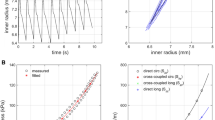Conclusions
1. The strength of the aorta wall in a direction transverse to the vessel axis exceeds the strength in the longitudinal direction by on average a factor of 1.9 in the thoracic and 1.8 in the abdominal sections.
2. The strength of the wall of the thoracic aorta is greater than that of the abdominal aorta. The differences between the strength characteristics of the aortal wall in the transverse direction are statistically reliable (up to 8th decade of life).
3. As the organism ages, the strength of the walls of the thoracic and abdominal aortas decreases in the longitudinal and transverse directions. This is indicated by the close inverse correlation between σ1, σ2 and age.
4. The strength of the aorta wall changes according to the period or stage of life. In each stage it is approximated by an exponential function.
5. The rate of decrease of the strength of the wall is less in the transverse than in the longitudinal direction during the initial or evolutive stage of life.
6. The decrease in strength (according to the criteria β, ϑ, ℵ) indicates more rapid aging of the tissues of the abdominal (relative to the thoracic) aorta. This difference appears after the age of 40 in the transverse and 50 in the longitudinal direction of the aorta wall.
Similar content being viewed by others
Literature cited
A. S. Obysov, Reliability of Biological Tissues [in Russian], Moscow (1971), pp. 12–28.
B. A. Purinya, G. L. Vilka, Yu. K. Vilks, V. A. Kas'yanov, and É. É. Tseders, "Variation of a number of mechanical properties of human blood vessels with age," Mekh. Polim., No. 1, 129–136 (1974).
Yu. A. Yartsev, "Morphological and functional aspects of the study of certain mechanical properties of the human aorta," Mekh. Polim., No. 4, 730–736 (1975).
Y. B. Fung, in: Sixth International Congress of Rheology. First International Congress of Biorheology, No. 1, Lyons (1972), p. 81.
É. É. Tseders, V. A. Kas'yanov, and B. A. Purinya, "Deformation of the human abdominal aorta in biaxial tension," Mekh. Polim., No. 3, 507–513 (1974).
É. É. Tseders, L. I. Slutskii, and B. A. Purinya, "Relation between the mechanical characteristics of the human abdominal aorta and its biochemical composition," Mekh. Polim., No. 4, 722–729 (1975).
N. N. Anichkov, "The vessels," in: A. I. Abrikosov, Special Pathological Anatomy [in Russian], Vol. 2, Moscow-Leningrad (1947), pp. 262–310.
N. S. Khamin, "Method of determining the mechanical properties of biological materials," in: Medical Technology [in Russian], Moscow (1975), pp. 55–58.
N. A. Plokhinskii, Biometry [in Russian], Moscow (1970).
G. F. Lakin, Biometry [in Russian], Moscow (1973).
L. Aschoff, Beihefte Medizin. Klinik,1, No. 1 (1908)
L. Aschoff, Beitr. Pathol. Anatom.,47, No. 1 (1910).
Additional information
Chita State Medical Institute. Translated from Mekhanika Polimerov, No. 1, pp. 104–108, January–February, 1977.
Rights and permissions
About this article
Cite this article
Khamin, N.S. Strength properties of the human aorta and their variation with age. Polymer Mechanics 13, 100–104 (1977). https://doi.org/10.1007/BF00857286
Received:
Issue Date:
DOI: https://doi.org/10.1007/BF00857286




